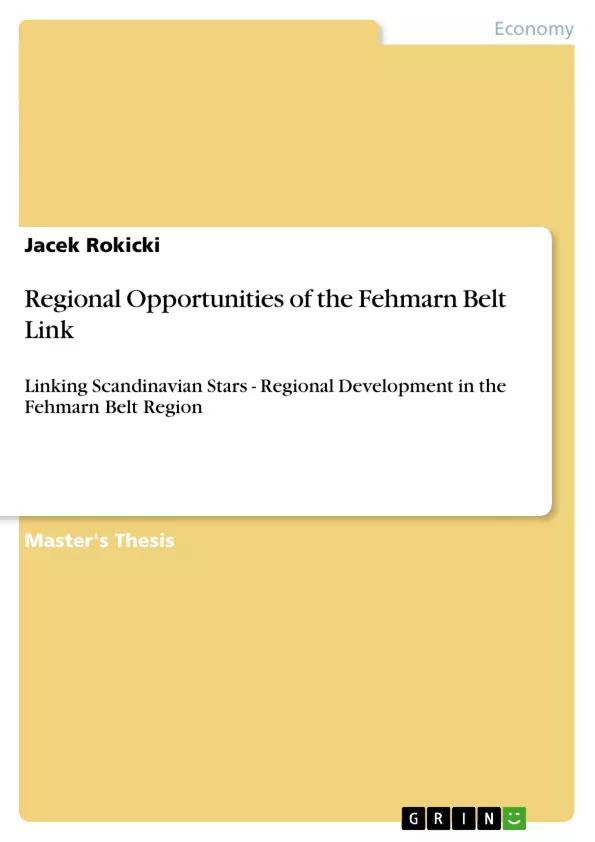The basic intension of this thesis is to analyse the potential of the Fehmarn Belt Region (FBR), which will gain in importance through the construction of the Fehmarn Belt Bridge (FBB) – as the last missing link between the two metropolitan regions of Copenhagen and Hamburg. The interest behind is the fact that the construction of the FBB is one of the few century structures with expected enormous wide-ranging effects. Many questions concerning the construction have arisen and this thesis has the intension of giving answers to some limited research questions. Now, almost 50 years later, this last missing link will be completed. Expectations as well as concerns on both sides of the Belt are enormous. We can infer from the treaty between Denmark and Germany, concerning the fixed link, it should improve the traffic infrastructure to stimulate freight- and passenger traffic on a regional and European level. Moreover, it has to accomplish better preconditions for an intensified cultural and economic cooperation and promote integration and dynamics in the region. It should forge new competitiveness and development in the relevant regions. In the meantime, the treaty was ratified on March 26, 2009 by the Folketinget and on July 10, 2009 by the Deutscher Bundestag. However, the bridge is not only of interest between the two national parliaments who are regarding this project as a transport policy key project that will cause positive economical effects for northern Europe and which can offer an alternative for migration out of the region. In early 1989, the two regional districts of Storstrøm and Ostholstein have handed in a resolution where they have formulated a demand to upgrade and strengthen the Vogelfluglinie to foster development in both districts. Additionally they have been considering the possibility of initiating cross-border cooperation together with the EU. Ultimately it has to be clarified to what extent this new infrastructure link will improve the accessibility of both metropolitan and the peripheral regions. Beside this, it will be of major importance to find out how far the reaches of the FBB will go. The link will then be the shortest and fastest connection between Scandinavia and the European continent and may have effects on the entire northern European transport corridors as well as on the European Urban System. It has to be ascertained if and in what way the FBB will influence it and to what extent it may change the system?
Inhaltsverzeichnis (Table of Contents)
- Preface
- 1. Introduction
- 1.1. Intension and requirement
- 1.2. Definition of the Fehmarn Belt Region
- 1.3. Methodology
- 2. European Urban System
- 3. Regional Development
- 4. Cross-border cooperation
- 5. Knowledge Economy
- 5.1. Life Science
- 6. Tourism Economy
- 7. Conclusion
- 8. Outlook
- 9. Literature
- 10. Figures
- Acknowledgements
Zielsetzung und Themenschwerpunkte (Objectives and Key Themes)
The main objective of this thesis is to examine the regional opportunities presented by the Fehmarn Belt Link, a bridge connecting Rødby (Denmark) and Puttgarden (Germany). The thesis aims to demonstrate the potential benefits of this project for both the peripheral regions of Denmark and Germany and to address the skepticism surrounding its construction. The thesis also investigates the “Øresund-effect” and its potential impact on the Fehmarn Belt Link project.
- The potential economic and social impacts of the Fehmarn Belt Link
- The role of cross-border cooperation in maximizing the benefits of the project
- The potential of the Fehmarn Belt Region for growth in knowledge-based industries
- The “Øresund-effect” and its implications for the Fehmarn Belt Link project
- The challenges and opportunities associated with developing peripheral regions
Zusammenfassung der Kapitel (Chapter Summaries)
The preface introduces the thesis and outlines the challenges and motivations behind its creation. The introduction (Chapter 1) defines the Fehmarn Belt Region and outlines the project's significance. It also discusses the methodology used in the study. Chapter 2 analyzes the European urban system and its implications for regional development. Chapter 3 focuses on regional development and its relevance to the Fehmarn Belt Link project. Chapter 4 explores the importance of cross-border cooperation in realizing the project's potential. Chapter 5 examines the knowledge economy and its potential for growth in the Fehmarn Belt Region, with a specific focus on life sciences in Section 5.1. Chapter 6 analyzes the tourism economy and its potential benefits from the Fehmarn Belt Link. The conclusion (Chapter 7) summarizes the key findings and the outlook (Chapter 8) provides future recommendations.
Schlüsselwörter (Keywords)
This study focuses on the potential impact of the Fehmarn Belt Link, a proposed bridge connecting Rødby, Denmark and Puttgarden, Germany, on regional development and the European urban system. Key concepts explored include cross-border cooperation, knowledge economy, life science, tourism, and the “Øresund-effect”. The research examines the challenges and opportunities of developing peripheral regions in the context of a major infrastructure project.
- Citation du texte
- Magister Artium Jacek Rokicki (Auteur), 2009, Regional Opportunities of the Fehmarn Belt Link, Munich, GRIN Verlag, https://www.grin.com/document/139932



